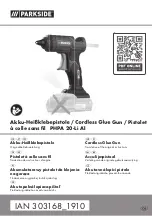
12
SET UP & PREPARATION
Connecting air supply
Under normal use conditions, the tool should be lubricated with air tool oil before
connecting the tool to an air supply. Add air tool lubricate into the air tool once
daily with minimal use, or twice a day with heavy use. Only a few drops of oil
at a time is necessary. Too much oil will only collect inside the tool and will be
noticeable in the exhaust cycle.
Before connecting the tool, check the air compressor gauge to be sure it is
functioning within the proper range 70 - 120psi (4.8 - 8.3bar).
Note:
The tool and air hose must have a quick-connect hose coupling that allows
all pressure to be removed from the tool
when the coupling is disconnected.
1.
Pull back the sleeve on female quick
connector hose coupling, insert male end
and release sleeve on quick connector
(fig. 1).
Note:
For best performance use 3/8” I/D
supply air hose.
WARNING!
Ensure the tool is in the off position before connecting to the
air supply.
WARNING!
Ensure that the compressed air does not exceed 120psi
(8.3bar) while operating the tool. Too high an air pressure and unclean
air will shorten the product’s life due to excessive wear, and may be
dangerous causing damage and/or personal injury.
Fig. 1
WARNING!
Always use a coupling that discharges all the compressed
air in the tool at the time the fitting or hose coupling is disconnected.
Using a coupling that does not discharge the compressed air could cause
unintended operation and serious personal injury..
WARNING!
Do not climb rigging or scaffolding while carrying a tool
that is connected to an air hose. Doing so could result in serious personal
injury.
WARNING!
The tool’s driving mechanism may cycle when the tool is first
connected to the air supply. Always connect the tool to pressurized air
supply before loading fasteners to prevent injury from unintended cycling.
Always make sure the tool’s magazine is empty at the beginning of each
work session, before connecting to an air supply.










































